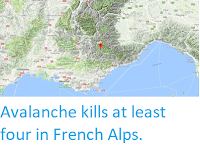A German skier has died after being caught in an avalanche while skiing near Grenoble in the French department of Isèreon Sunday 18 March 2018. The unnamed 25-year-old man was one of a party of five who were caught in the event when the snow gave way downslope of them. A second skier, Katie Combaluzier, 24, from Toronto, who was studying medicine in Dublin, suffered a fractured spine and other injuries in the same incident.
Katie Combaluzier, 24, from Toronto, injured by an avalache in the French Alps on 18 March 2018. CBC News.
Avalanches are caused by the mechanical failure of snowpacks;
essentially when the weight of the snow above a certain point exceeds
the carrying capacity of the snow at that point to support its weight.
This can happen for two reasons, because more snow falls upslope,
causing the weight to rise, or because snow begins to melt downslope,
causing the carrying capacity to fall. Avalanches may also be triggered
by other events, such as Earthquakes or rockfalls. Contrary to what is
often seen in films and on television, avalanches are not usually
triggered by loud noises. Because snow forms layers, with each layer
typically occurring due to a different snowfall, and having different
physical properties, multiple avalanches can occur at the same spot,
with the failure of a weaker layer losing to the loss of the snow above
it, but other layers below left in place - to potentially fail later.
Diagrammatic representation of an avalanche, showing how layering of snow contributes to these events. Expedition Earth.
The Alps have seen a number of avalanche related incidents this winter, largely due to high levels of snowfall. This is, in turn caused by warmer conditions over the Atlantic, which leads to higher rates of evaporation over the ocean, and therefore higher rates of precipitation over Europe, which falls as snow in cooler regions such as the Alps, where the moist air meets cold air fromt the east.
See also...
Follow Sciency Thoughts on Facebook.








